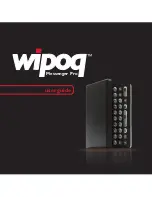
LGE Internal Use Only
Copyright © 2008 LG Electronics. Inc. All right reserved.
Only for training and service purposes
- 36 -
3.8.8 Wideband CODEC
The MSM6280 device integrates a wideband voice/audio CODEC into the mobile station modem
(MSM). The CODEC supports two differential microphone inputs, one differential earphone output, one
single-ended earphone output, and a differential analog auxiliary interface. The CODEC integrates the
microphone and earphone amplifiers into the MSM6280 device, reducing the external component
count to just a few passive components. The microphone (Tx) audio path consists of a two-stage
amplifier with the gain of the second stage set interally. The Rx/Tx paths are designed to meet the
ITU-G.712 requirements for digital transmission systems.
3.8.9 Vocoder Subsystem
The MSM6280 device’s QDSP4000 supports AMR,FR,EFR and HR. In addition, the QDSP4000 has
modules to support the following audio functions: DTMF tone generation, DTMF tone detection, Tx/Rx
volume controls, Tx/Rx automatic gain control (AGC), Rx Automatic Volume Control (AVC), EarSeal
Echo Canceller (ESEC), Acoustic Echo Canceller (AEC), Noise Suppression (NS), and programmable,
13-tap, Type-I, FIR, Tx/Rx compensation filters. The MSM6280 device’s integrated ARM9TDMI
processor downloads the firmware into the QDSP4000 and configures QDSP4000 to support the
desired functionality.
3.8.10 ARM Microprocessor subsystem
The MSM6280 device uses an embedded ARM926EJ-S microprocessor. This microprocessor,
through the system software, controls most of the functionality for the MSM device, including control of
the external peripherals such as the keypad, LCD, RAM, ROM, and EEPROM devices. Through a
generic single serial bus interface (SSBI) the ARM926EJ-S configures and controls the functionality of
the RFR6275, RFR6250, and PM6650-2/PM6650-3 devices. For the RFCMOS platform, SSBI (single-
wire SBI) will be supported.
3.8.11 Mode Select and JTAG Interfaces
The mode pins to the MSM6280 device determine the overall operating mode of the ASIC. The options
under the control of the mode inputs are Native mode, which is the normal subscriber unit operation,
ETM mode, which enables the built-in trace mode, and test mode for factory testing. The MSM6280
device meets the intent of the ANSI/IEEE 1149.1A-1993 feature list. The JTAG interface can be used
to test digital interconnects between devices within the mobile station during manufacture.
3.8.12 General-Purpose Input/Output Interface
The MSM6280 device has general-purpose bidirectional input/output pins. Some of the GPIO pins
have alternate functions supported on them. The alternate functions include USB interface, additional
RAM, ROM, general-purpose chip selects, parallel LCD interface, and a UART interface. The function
of these pins is documented in the various software releases.
Z3X-BOX.COM
Summary of Contents for L705ix
Page 185: ...Note Z 3 X B O X C O M ...
Page 186: ...Note Z 3 X B O X C O M ...
















































